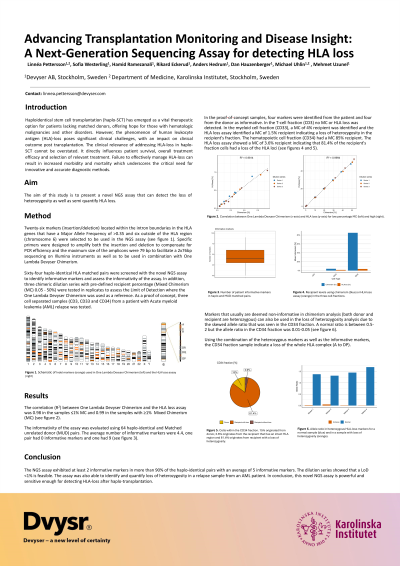Back

Advancing Transplantation Monitoring and Disease Insight: A Next-Generation Sequencing Assay for detecting HLA loss
(P703) Advancing transplantation monitoring and disease insight
Location: Platinum Ballroom

Poster Presenter(s)
Aim: Haploidentical stem cell transplantation (haplo-SCT) is an alternative therapeutic option, for patients with hematologic malignancies lacking matched related or unrelated donors. However, loss of parts or whole genes of the human leukocyte antigen (HLA-loss) in a malignant clone poses significant clinical challenges and inferior patient outcome. The clinical relevance of addressing HLA-loss in haplo-SCT is important since it directly influences disease recurrence, overall treatment efficacy, selection of treatment and patient survival. The aim of this study was to develop a novel NGS assay that can detect and quantify the loss of heterozygosity within the HLA locus.
Method: HLA locus specific and non-HLA specific indel (insertion/deletion) markers were selected to be included in the NGS assay. Specific primers were designed to amplify both the insertion and deletion to compensate for PCR efficiency and the maximum size of the amplicons were 75 bp to facilitate a 2x76bp sequencing on Illumina instruments as well as to be used in combination with One Lambda Devyser Chimerism.
55 haplo-identical HLA matched pairs were screened to identify informative markers and assess the informativity of the assay. In addition, chimeric dilution series with pre-defined recipient percentage were tested to assess the Limit of Detection. As proof of concept, five AML patients with relapse were screened for HLA loss.
Results: Of the 55 haplo-identical pairs, informative markers were found in 96%. The NGS assay exhibited at least 2 informative markers in 91% of the haplo-identical pairs with an average of 4 informative markers. Analysis of the dilution series demonstrated a LoD of below 0,5%.
Five AML patients with relapse were screened for HLA-loss and the results indicated HLA loss in one case. The patient had relapsed and routine chimerism analysis showed recipient levels of 4% in the CD33 fraction and 85% in the CD34 fraction. The markers in the HLA locus, however, showed recipient levels of 0% for CD33 and only 3% for the CD34 fraction, indicating loss of heterozygosity.
Conclusion: Results obtained show that the novel NGS assay has excellent informativity and indicates sufficient sensitivity. The ability to identify loss of HLA in patients with disease relapse allows for adequate measures and improved treatment management.
Method: HLA locus specific and non-HLA specific indel (insertion/deletion) markers were selected to be included in the NGS assay. Specific primers were designed to amplify both the insertion and deletion to compensate for PCR efficiency and the maximum size of the amplicons were 75 bp to facilitate a 2x76bp sequencing on Illumina instruments as well as to be used in combination with One Lambda Devyser Chimerism.
55 haplo-identical HLA matched pairs were screened to identify informative markers and assess the informativity of the assay. In addition, chimeric dilution series with pre-defined recipient percentage were tested to assess the Limit of Detection. As proof of concept, five AML patients with relapse were screened for HLA loss.
Results: Of the 55 haplo-identical pairs, informative markers were found in 96%. The NGS assay exhibited at least 2 informative markers in 91% of the haplo-identical pairs with an average of 4 informative markers. Analysis of the dilution series demonstrated a LoD of below 0,5%.
Five AML patients with relapse were screened for HLA-loss and the results indicated HLA loss in one case. The patient had relapsed and routine chimerism analysis showed recipient levels of 4% in the CD33 fraction and 85% in the CD34 fraction. The markers in the HLA locus, however, showed recipient levels of 0% for CD33 and only 3% for the CD34 fraction, indicating loss of heterozygosity.
Conclusion: Results obtained show that the novel NGS assay has excellent informativity and indicates sufficient sensitivity. The ability to identify loss of HLA in patients with disease relapse allows for adequate measures and improved treatment management.

